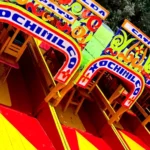Xochimilco, a place now synonymous with colorful trajineras, vibrant festivities, and lively canals, has a history dating back to pre-Hispanic times. This site, whose name in Nahuatl means “place of the flower fields,” is one of the oldest and culturally richest corners of Mexico City.
The First Inhabitants and the Rise of the Chinampas
Xochimilco was founded by the Xochimilcas, a Nahuatl-speaking group that settled in the region around the 9th century A.D. What made this group unique was their development of an advanced agricultural system known as chinampas. These “floating gardens” were, in reality, fertile plots of land created on the region’s lakes, allowing year-round cultivation. This ingenious method not only provided sustenance for the local inhabitants but also became an integral part of regional trade.
The chinampas of Xochimilco were so successful that during the height of the Aztec Empire, they became the granary of the capital, Tenochtitlán. Thanks to them, the Aztec population was supplied with corn, beans, chili, and flowers—essential products for daily life and religious ceremonies.
Cultural and Spiritual Importance of Xochimilco
Beyond its agricultural prowess, Xochimilco has always been a place of profound cultural and spiritual importance. The canals and lakes not only supported life but also housed rich biodiversity, including the axolotl, an endemic species with a significant role in Aztec mythology.
With the arrival of the Spanish in the 16th century, Xochimilco became a key point in the evangelization of indigenous peoples. Despite European influence, Xochimilca traditions and culture managed to survive. Today, many of those traditions are still celebrated, blending pre-Hispanic and Christian elements, making Xochimilco a symbol of cultural resilience.
Xochimilco Today: A World Heritage Site
In 1987, UNESCO declared the canals of Xochimilco a World Heritage Site, recognizing its historical, cultural, and ecological value. This recognition not only underscores the importance of preserving this unique site but also places it on the global map as a must-visit destination for those who wish to understand the deep roots of Mexican culture.
Today, Xochimilco remains a place where history and modernity meet. The trajineras, adorned with flowers and the names of loved ones, sail along the same canals that once supported the mighty Aztec Empire. Visitors can enjoy mariachi music, traditional food, and immerse themselves in an atmosphere that, while having changed over the centuries, still retains the spirit of its first inhabitants.
Book our tour here!










